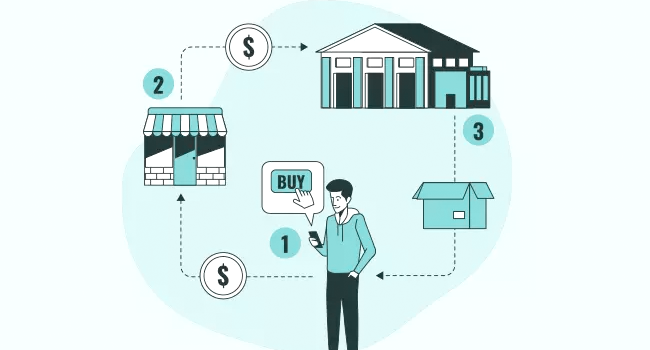Dropshipping Success: Building a Profitable E-Commerce Business

In the ever-evolving landscape of e-commerce, dropshipping has emerged as a popular and lucrative business model. However, achieving dropshipping success requires more than just setting up a website and listing products.
In this complete guide, we will delve into the intricacies of dropshipping and provide you with the knowledge and strategies to build a profitable e-commerce business.
Understanding Dropshipping
A retail fulfillment technique called dropshipping allows an online retailer to sell goods without maintaining inventory. When a store sells something, it buys it from someone else and ships it to the buyer. It is optional for the store owner to view or touch the merchandise. This business model has several key advantages:
- Low Initial Investment
Unlike traditional retail businesses, you don’t need to invest heavily in inventory. You only purchase products when you’ve already made a sale.
- Low Overheads
With no need for warehousing, there’s no expense associated with storage or the management of inventory.
- Wide Product Selection
You are able to offer a wide variety of products without being limited by the need for physical storage because you are not required to store inventories.
- Flexibility
You can run your dropshipping business from anywhere as long as you have an internet connection, making it a location-independent venture.
Choosing a Niche
Choose a specialty that fits with your knowledge, interests, and market needs before you jump right into dropshipping. The following are the steps to selecting a lucrative niche:
- Research Market Trends
Use tools like Google Trends, Amazon Best Sellers, and eBay’s Most Watched Items to identify products that are currently in demand.
- Evaluate Competition
Analyze your potential competitors in the chosen niche. If the Competition is too fierce, it may be easier to establish a foothold.
- Consider Profit Margins
Look for products with healthy profit margins. Higher-priced items can offer better returns, but you should also consider demand and Competition.
- Passion and Knowledge
Choose a niche you are passionate about and have some knowledge of. It will make marketing and customer engagement easier.
- Seasonal Considerations
Some products are highly seasonal, so take into account the time of year and whether your niche is affected by it.
Setting Up Your E-Commerce Store
Once you’ve identified your niche, it’s time to create your online store. Here are the essential steps to setting up your e-commerce business:
- Domain and Hosting
Choose a memorable domain name that appropriately sums up your company. Pick a trustworthy hosting provider to guarantee the speed and accessibility of your website.
- E-Commerce Platform
Numerous e-commerce platforms are available, including BigCommerce, WooCommerce, and Shopify. Pick the option that best fits your demands and price range.
- Design and Branding
Customize your website’s design to create a cohesive and appealing brand image. Pay attention to user experience and make sure the site is easy to navigate.
- Product Listings
Import or manually add product listings to your store. Ensure that product descriptions and images are high-quality and informative.
- Payment Processing
Set up a secure and convenient payment processing system to accept payments from your customers.
- Shipping and Returns
Clearly define your shipping policies and procedures for handling returns or exchanges. Transparent shipping and return policies can build trust with customers.
- Legal Requirements
Familiarize yourself with legal requirements, such as business registration, taxation, and compliance with consumer protection laws.
Sourcing Suppliers
Choosing reliable suppliers is a critical aspect of dropshipping success. Your suppliers play a pivotal role in delivering quality products on time. Here are some tips for sourcing suppliers:
- Research Multiple Suppliers
Consider using established dropshipping platforms like AliExpress, SaleHoo, or Worldwide Brands to find reputable suppliers. Check for their reputation and customer reviews.
- Communicate with Suppliers
Establish clear communication with your suppliers. Ensure they have good customer service and can provide you with tracking information for orders.
- Product Quality
Sample products from potential suppliers to assess their quality. It would help if you were confident in the products you’re selling to maintain customer satisfaction.
- Shipping Times
Understand the shipping times offered by your suppliers. Delays can result in customer dissatisfaction, so choose suppliers who can deliver within reasonable timeframes.
Marketing Your Dropshipping Business
Effective marketing is essential to drive traffic to your e-commerce store and convert visitors into customers. Here are some marketing strategies to consider:
- Social Media Marketing
Leverage popular social media platforms to engage with your target audience. Regular posts, stories, and paid advertising can help increase your reach.
Customer Service and Support
Having top-notch customer support is crucial for dropshipping businesses to succeed in the long run. Here are some pointers for efficient client service:
- Handling Returns and Refunds
Have a clear and fair return policy in place. Address return requests quickly and provide refunds as needed to maintain customer satisfaction.
- Product Information
Ensure that your product listings contain accurate and detailed information, including size charts, product dimensions, and care instructions.
Scaling Your Dropshipping Business
Once your dropshipping business is up and running, you can explore ways to scale and increase your profits:
- Expand Product Range
Gradually add new products to your catalog to attract a broader audience. Research trends and customer preferences to make informed decisions.
- Marketing Investment
Allocate a portion of your profits into marketing to drive more traffic and sales. Scaling often requires increased marketing efforts.
- Customer Loyalty Programs
Implement loyalty programs to encourage repeat business. Offer discounts, rewards, and exclusive promotions to loyal customers.
- Partnerships and Collaborations
Explore partnerships with other businesses or influencers to tap into new customer bases and gain exposure.
- International Expansion
Consider expanding your dropshipping business to international markets. Research shipping and customs requirements for international orders.
- Overcoming Challenges
While dropshipping offers numerous advantages, it has its challenges. Here are common issues and how to overcome them:
- Supplier Reliability
Some suppliers may need to meet your expectations. Always have backup suppliers in case of issues with your primary ones.
- Quality Control
Ensure that the products you sell meet quality standards. Test products or request samples to avoid selling low-quality items.
- Shipping Delays
Keep customers informed about expected shipping times and potential delays. Offer options for expedited shipping to manage expectations.
- Competition
Stay competitive by offering unique products, excellent customer service, and effective marketing strategies.
- Seasonal Fluctuations
Prepare for seasonal changes in demand by adjusting your product offerings and marketing efforts accordingly.
Monitoring and Analytics
Regularly monitoring the performance of your dropshipping business is crucial for success. Make data-driven decisions by using analytics tools and key performance indicators (KPIs) to track your progress:
- Sales and Revenue
Track your sales and revenue to identify trends and assess the financial health of your business.
- Conversion Rate
Monitor your conversion rate to understand how well your website converts visitors into customers.
- Website Traffic
Analyze your website traffic to identify the sources of visitors and which marketing channels are most effective.
- Customer Feedback
Pay attention to customer feedback and reviews to improve your products and services continuously.
Conclusion
A successful dropshipping e-commerce business needs commitment, thoughtful strategy, and constant work. Dropshipping has a low entrance barrier, but its success depends on finding the proper niche, working with trustworthy suppliers, using smart marketing techniques, and offering top-notch customer support.
By following the steps outlined in this guide and staying adaptable, you can establish and grow a lucrative e-commerce venture that fulfills your entrepreneurial aspirations. Remember that the e-commerce landscape is ever-changing, and your willingness to learn and adapt will be instrumental in your long-term success. With persistence and a commitment to delivering value to your customers, you can achieve your dropshipping business goals and build a profitable online enterprise.
FAQs
Q1: What is dropshipping, and how does it work?
A retail fulfillment strategy called dropshipping allows an online retailer to sell goods without maintaining inventory. Rather, the goods are bought by the retailer from a third-party supplier upon a client’s request, and it is shipped straight to the consumer. The proprietor of the shop does not handle or store the merchandise.
Q2: Is dropshipping a profitable business model?
A: Dropshipping can be profitable, but success depends on various factors, including niche selection, effective marketing, reliable suppliers, and good customer service. Like any business, it requires effort and dedication.
Q3: How much does it cost to start a dropshipping business?
A: The cost to start a dropshipping business can be relatively low compared to traditional retail. You’ll need a domain, hosting, an e-commerce platform (like Shopify or WooCommerce), and funds for marketing. The exact amount varies, but it can be started with a few hundred dollars.
Q4: Do I need to hold inventory in a dropshipping business?
A: No, one of the advantages of dropshipping is that you don’t need to hold inventory. You only purchase products when you’ve already made a sale, reducing upfront costs and the risk of unsold inventory.
Q5: How do I find reliable suppliers for my dropshipping business?
A: You can find suppliers on platforms like AliExpress, SaleHoo, and Worldwide Brands. Research potential suppliers, look for reviews, and communicate with them to ensure their reliability and product quality.






